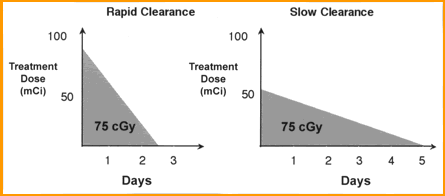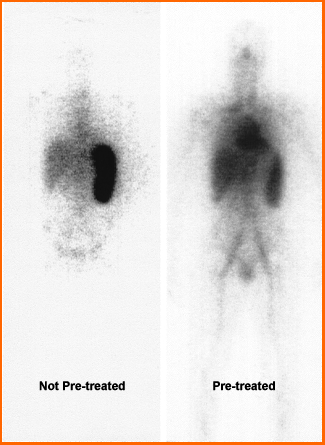- The most commonly occurring hematological cancer in the US that ranks sixth in leading cancer death
- Approximately 98,982 people died of NHL between 1990 to 1994. In 2004, the estimate is around 21,000
- For more information on cancer mortality rates in US go to the following link: http://cancercontrolplanet.cancer.gov/atlas/timeall.jsp?ac=1
- Histological there are three grades of NHL (low, medium, and high). This ranking is related to: the progression of the disease, relapse after chemotherapy, and the patient's life expectancy
- Known as immunotherapy where a specific monoclonal antibody is developed
to treat disease. Why does Bexxar work?
- It recognizes a specific protein found on a tumor cell
- Without a radioactive tracer it, the moab can binds to the tumor cell causing apoptosis(cell death)
- The moab specifically targets the CD20 antigen that is located on the surface of malignant and normal lymphocytes
- Radioimmunotherapy application
and use of beta radiation
- Allows for specific targeting of tumor cells yet significantly reduces the radiation burden to the patient
- 131I -beta particles travel approximately 0.8 mm, which is about 70 to 80 times the diameter of a lymphocyte. Therefore, after the radio-moab attaches to the tumor surface beta-particles destroy the tumor. This is sometimes referred to as "crossfire effect"
- Because of specific targeting of the tumor cells health tissue receives a lot less radiation, which overall reduces the radiation burden to the patient

- The above charge shows the development of B-lymphocytes
and several points are pertinent to our understanding of why this therapy works so well
- The moab is stable, tumor-specific, and attaches to the surface of the Antigen (these are all ideal properties)
- Note the development of the B cell and when the CD20 expression occurs on the surface of the B-lymphocyte
- The undifferentiated stem cell does not have the CD20 expression, hence the radiation burden to those cells that procedure lymphocytes are not "effected"
- The B-cell type lymphoma has the CD20 expression that allows for radioimmunotherapy
- The therapeutic dose
- Maximum total body dose is between 65 - 75 cGy
- At issue is that the biological T1/2 varies between patients
- Hence, it is important to determine how quickly a patient eliminate the radio-moab
- The faster the body eliminate the moab the higher the dose must be
- Consider the variation of 131I given to patients that has hyperthyroidism (size of the gland and uptake is taken into account). With Bexxar the same principle applied
- How is the therapeutic dose determined?
- 5mCi of 131I-tositumomab is given to the patient
- 131I standard must be kept for the procedure
- On the 2nd, 3rd, or 4th day a whole-body scan is acquired and can be collected within a 2-minute time frame (we're not concerned about resolution, just want to look at count distribution)
- A second whole body scan is completed on the 6th or 7th day
- All data must be acquired with a computer
- Patient counts, standard counts, and background counts are determined from both whole body scans
- Standard is used as QC, to take into account possible variations in the gamma camera's ability to pickup counts over the different times the whole body scan is acquired (consider the use of a standard in thyroid uptake - its the same principle)
- Patient background counts are used to determine dose residence time
- Key - determine when the activity drops to 37% from the initial administration


- Notice the difference between the pre-treatment (tositumomab) image and non pre-treated
- The non-treated image shows that a significant portion of the radiotracer has gone to spleen
- If the same process was used in the therapeutic dose of tositumomab, too much of the radiotracer would radiate the wrong cells and tissue
- Two aspects occur with pre-treatment
- Reduces a immune cytotoxic response
- Cold moab binds to the non tumor B-cells, hence blocking uptake of the radioactive moab
- Multicenter single-arm study
- Forty patients were initially studied
- Overall response 68%
- Complete response 33% after 26 months
- Collimator for 364 keV gamma with less than 7% septal penetration
- Single or dual detectors with whole body imaging capacity
- Use 20 - 25% window
- Use minimum whole body matrix if more than one is available
- Scan speed 10-30 cm/minute, however for predosing see above
- Prior to any radioactive dose potassium iodine must be administered
- Dosing
- OD - One day prior
- OD - Continue for fourteen days
- Dosing is specifically calculated for each patient and is determined by the initial 5mCi dose, see above. Once the dosimetry is determined the following platelet counts defines the actual dose.
- Platelets/mm 3 is >150k patient’s whole body dosimetry should be 75 cGy
- Platelets/mm 3 is between 150k-100k patient patient’s whole body dosimetry should be 65 cGy
- Platelets/mm 3 is <100k should not undergo treatment
- Calculation of this dose will be discussed in clinic



